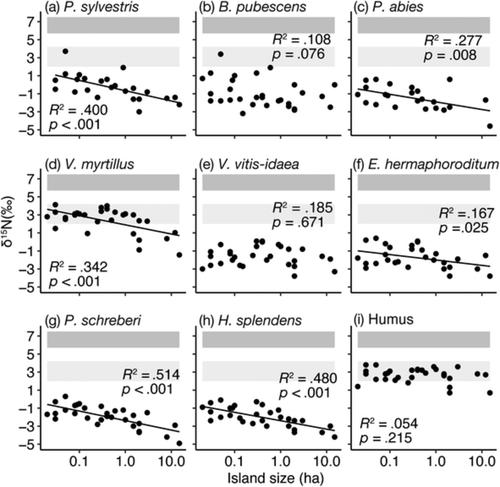当前位置:
X-MOL 学术
›
Ecol. Res.
›
论文详情
Our official English website, www.x-mol.net, welcomes your
feedback! (Note: you will need to create a separate account there.)
Changes in stable nitrogen isotopes of plants, bulk soil and soil dissolved N during ecosystem retrogression in boreal forest
Ecological Research ( IF 1.7 ) Pub Date : 2021-02-18 , DOI: 10.1111/1440-1703.12208 Fujio Hyodo 1 , Yu Takebayashi 2 , Akiko Makabe 2, 3 , David A. Wardle 4 , Keisuke Koba 2, 5
Ecological Research ( IF 1.7 ) Pub Date : 2021-02-18 , DOI: 10.1111/1440-1703.12208 Fujio Hyodo 1 , Yu Takebayashi 2 , Akiko Makabe 2, 3 , David A. Wardle 4 , Keisuke Koba 2, 5
Affiliation

|
Stable nitrogen isotope ratios (δ15N) of plants and soil have been used to study changes in the N cycle during ecosystem succession and retrogression. However, little is known about how δ15N of soil mineral N and dissolved organic N (DON) change during retrogression, despite their potential to inform on processes contributing to N loss. Here, we examined the δ15N of NH4+ and DON together with δ15N of the dominant plant species and bulk soil across a 5,000‐year‐old retrogressive chronosequence of forested islands in northern Sweden. The δ15N of bulk soil N, NH4+ and DON did not change greatly during retrogression, suggesting that there are no major losses of N from the system. The δ15N of NH4+ and DON was significantly correlated with that of bulk soil N across islands, indicating that bulk soil N is an important determinant of the δ15N of dissolved soil N. The δ15N of DON was significantly higher than those of NH4+ and bulk soil N, probably because of the inclusion of microbial N to the DON fraction. Despite the lack of changes in δ15N of soil N as retrogression proceeded, the δ15N of most plant species increased. These results suggest that despite the relative importance of the three underlying mechanisms involved is unclear, the N resources of plants change in response to retrogression: they have an increasing reliance on DON, a decreasing dependence on N transferred from the mycorrhizal fungi and reduced reliance on N from surface soil layers as retrogression proceeds.
中文翻译:

北方森林生态系统退化过程中植物,块状土壤和土壤可溶性氮的稳定氮同位素变化
稳定的氮同位素比(δ 15植物和土壤中的N)生态系统演替和倒退期间已被用于在所述N个循环研究的变化。然而,很少有人知道如何δ 15的土壤矿物N N和倒退时,溶解的有机N(DON)的变化,尽管它们的潜力上有助于氮损失进程通知。在这里,我们研究了δ 15 ñ的NH 4 +与δ和DON一起15主要植物叶和土体氮横跨在瑞典北部森林岛的5000年历史的倒退年代序列。的δ 15的散装土壤N,NHÑ 4 +DON在回归过程中变化不大,这表明系统中N的损失不大。的δ 15 ÑNH的4 +和DON被显著与跨越岛屿散装土壤N个相关的,表明散装土壤N是δ的重要决定因素15溶解土壤N的N个δ 15 DON的n为显著更高NH 4 +和块状土壤N的氮含量可能要高于DON中的微生物氮含量。尽管缺乏δ变化的15土壤N N为倒退的进行,δ 15大多数植物中的N增加。这些结果表明,尽管尚不清楚所涉及的三种潜在机制的相对重要性,但植物的氮资源却随着退化而变化:它们对呕吐毒素的依赖性增加,对从菌根真菌转移的氮的依赖性降低,对氮的依赖性降低。随着退化的进行,土壤表层的N逐渐增加。
更新日期:2021-02-18
中文翻译:

北方森林生态系统退化过程中植物,块状土壤和土壤可溶性氮的稳定氮同位素变化
稳定的氮同位素比(δ 15植物和土壤中的N)生态系统演替和倒退期间已被用于在所述N个循环研究的变化。然而,很少有人知道如何δ 15的土壤矿物N N和倒退时,溶解的有机N(DON)的变化,尽管它们的潜力上有助于氮损失进程通知。在这里,我们研究了δ 15 ñ的NH 4 +与δ和DON一起15主要植物叶和土体氮横跨在瑞典北部森林岛的5000年历史的倒退年代序列。的δ 15的散装土壤N,NHÑ 4 +DON在回归过程中变化不大,这表明系统中N的损失不大。的δ 15 ÑNH的4 +和DON被显著与跨越岛屿散装土壤N个相关的,表明散装土壤N是δ的重要决定因素15溶解土壤N的N个δ 15 DON的n为显著更高NH 4 +和块状土壤N的氮含量可能要高于DON中的微生物氮含量。尽管缺乏δ变化的15土壤N N为倒退的进行,δ 15大多数植物中的N增加。这些结果表明,尽管尚不清楚所涉及的三种潜在机制的相对重要性,但植物的氮资源却随着退化而变化:它们对呕吐毒素的依赖性增加,对从菌根真菌转移的氮的依赖性降低,对氮的依赖性降低。随着退化的进行,土壤表层的N逐渐增加。











































 京公网安备 11010802027423号
京公网安备 11010802027423号